This year, the 50th anniversary special of Doctor Who, “The Day of the Doctor,” introduced us properly to the War Doctor. This previously unknown incarnation of the hero, played by John Hurt, wore an outfit combining elements of the Eighth Doctor’s with the leather jacket of the Ninth, plus a belt taken from a woman named Cass whom the hero had previously failed to save. “The Day of the Doctor” also featured another version of the hero who had previously only appeared in the novel Summer Falls by Amelia Williams (AKA Amy Pond).
Over the years, there have been other interesting alternative takes on the Time Lord scientist of the planet Gallifrey. So this time around, we’re looking at the “what could have been” and “almost were” versions of the Doctor, along with costumes the character has worn in licensed media. Fan-films and the like aren’t included or we’d be here forever, even if we had a time machine.
DR. WHO
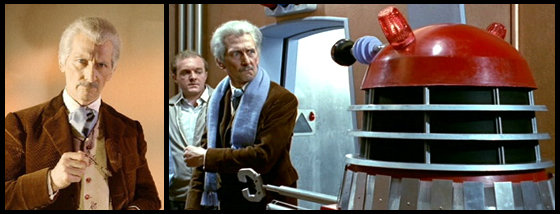
The 1965 theatrical film Dr. Who and the Daleks and its 1966 sequel, Daleks – Invasion Earth: 2150 AD, were adaptations of the first two Dalek stories from the TV program. They starred Peter Cushing as the hero, but he wasn’t an alien exile from “another time, another world.” He was a British scientist living in London literally named Dr. Who (which was going to be his alias originally in the TV show before it was changed to “the Doctor”). This human scientist piloted a time machine of his own creation that he named Tardis (as opposed to “the TARDIS”).
The TV version of the Doctor wore anachronistic clothing, looking as if he belonged to the 19th century while he stood in his futuristic spaceship. But this movie Dr. Who (I like to imagine his first name was something akin to Phineas, Curtis or Ichabod) looked like the typical idea of an old-fashioned British academic in the 1960s. Not bad, but a little bland in comparison to the Time Lord version.
Though these stories were out of continuity, Cushing later suggested a way to consider them canon. He proposed he was a future incarnation of the Doctor, rendered amnesiac and imprisoned by the villain known as the Celestial Toymaker (a cosmic trickster who appeared in William Hartnell episodes), forced to live out alternative versions of his early adventures.
THE VALEYARD

In the mid 1980s, BBC Controller Michael Grade wanted to cancel Doctor Who, arguing it was embarrassing and that science fiction was a genre for America rather than British television. Producer John Nathan-Turner and script editor Eric Saward decided to symbolize this pressure with a season-long story arc “The Trial of a Time Lord.” For the third time since the classic program began, the Doctor was put on trial by the Time Lords and faced possible execution. The prosecutor was a Time Lord known as the Valeyard (played by Michael Jayston).
The Valeyard did not dress in typical Time Lord attire, choosing instead a black robe and simple cap that gave him the air of being a dark wizard. The original intention was that the Valeyard would be the Thirteenth Doctor, corrupted by his desire to survive past the thirteen life limit Time Lords have. Producer Nathan-Turner later decided to change this. In the version of the penultimate chapter that aired, the Master appears and reveals that the Valeyard is a physical manifestation of the Doctor’s dark side, somehow created in a possible future, an unforeseen result of the regeneration from the Eleventh to the Twelfth Doctor.
The Valeyard was defeated and never showed up again. Recently, the officially licensed Big Finish audio drama The Trial of the Valeyard brought back the villain. In the story, the Valeyard claimed he was created by the Thirteenth Doctor’s experiment to break the thirteen life limit. The Sixth Doctor believed this was a lie, but admitted there might be some sliver of truth hidden in the story.
In the 2010 episode “Amy’s Choice,” the Eleventh Doctor encountered a manifestation of his darker nature, a being dressed in attire similar to his own. Some wondered if this was the beginning of a new version of the Valeyard.
THE SIXTH DOCTOR’S OTHER LOOKS
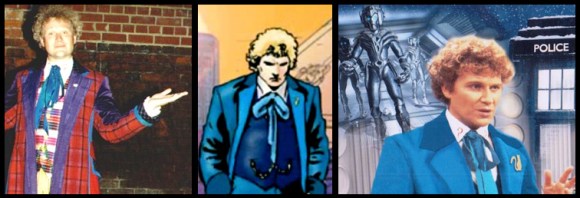
Colin Baker didn’t get the attire he wanted the Sixth Doctor to wear. Initially, Baker wanted a black outfit akin to the Master’s style, as his Doctor was supposed to start off as a darker character that then mellowed into a more compassionate hero. But Nathan-Turner wanted him in an outfit that was “totally tasteless” and so we got what looked as if the 1980s fashion scene exploded onto one coat.
But the Sixth Doctor did get a couple of alternate outfits off-screen. In the stage production Doctor Who: The Ultimate Adventure (previously starring Third Doctor Jon Pertwee), Baker sported a somewhat less garish coat. Over a decade later, the Doctor Who website released the Sixth Doctor audio drama Real Time, accompanying it with Flash animation. Baker’s coat was too nuts to animate, so his incarnation donned an all-blue ensemble.
The blue look became popular and has continued to be used in many tie-in media stories. The color reflects the Sixth Doctor’s more somber nature and calls back to his TV adventure “Revelation of the Daleks,” which revealed that many planets consider blue, rather than black, to be a color of mourning.
THE REBOOT DOCTOR
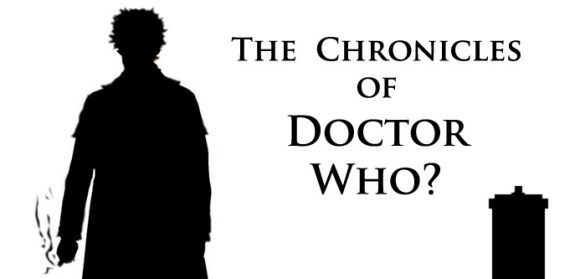
This version of the Doctor has never appeared, but it’s worth mentioning as a massive “Oh my God, what if they had done that?” In 1996, the Doctor Who TV-movie introduced Paul McGann as the Eighth Doctor. Though it did well in the UK, the US numbers weren’t good enough for Fox, and no series materialized.
But originally, the TV-movie was going to reboot Doctor Who from ground zero, under the possible titles The Chronicles of Doctor Who? or simply Doctor Who? In the reboot series bible, this reboot version of the Doctor is heir to the royal line of Gallifrey and a threat to its current ruler, his half-brother the Master. The Master’s sends his deadly minions, the Daleks (spider-legged in this version), to kill the Doctor. This prompts the hero to leave Gallifrey, beginning journeys through time and space that make up a quest to find his missing father Ulysses (known on Earth as Blackbeard the Pirate). In this reboot, the TARDIS only has five rooms, houses a pumpkin-shaped alien named Gog, and its circuits are inhabited by the ghost of the Doctor’s grandfather Barusa (who was a teacher of his in the Classic Doctor Who era). Not weird enough? The emotionless Cybermen are renamed the Cybs, incredibly vain villains who have a cyborg dog. Cyborg. Dog.
So what did the Doctor himself look like in this reboot? The series bible said he was a ruggedly handsome, unshaven character who smoked cigars and wore a long leather duster decorated by many buckles and pockets. He was gritty and rough-edged.
Some of you want to cry “stupid Americans, ruining Doctor Who!” But this was a joint project between Fox and BBC Worldwide, the latter of which wanted to reboot the franchise and objected to references to the classic series. Second, although Fox is American, the producers and writers were British. Third, the early 1990s attempts by the Green Light production company to create a theatrical film were often worse. Depending on what draft of their movie script you read, the Doctor was a member of the Time Rangers, had no problem snapping his enemies’ necks, took LSD, and/or revealed that his real name was “Theo.” Oh, did I mention Pog, the Latin-speaking pet that inhabited the TARDIS garden? Yeah, it was nuts.
McGANN’S LEATHER LOOK
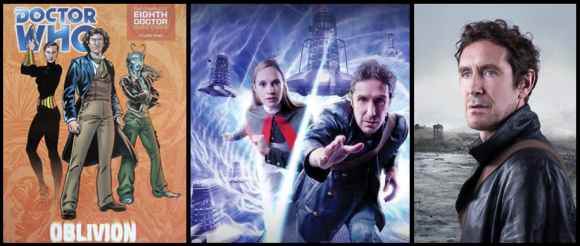
Though initially not sure if he was the right choice to be the Eighth Doctor, Paul McGann became excited for the role and signed on to play it for six seasons if a series emerged. Wishing to explore a darker, edgier nature, the actor suggested his Doctor could sport short hair and a leather jacket. He was told emphatically “no,” as the producers believed that such a design was antithetical to Doctor Who and would never be accepted by fans. A Byronic style (involving parts of a Wild Bill Hickok costume) was used instead.
The Eighth Doctor had a couple of different looks in the comics of Doctor Who Magazine, where were done in the same vein as the movie. In 2001, McGann started regularly starring in fully-cast audio dramas of the Eighth Doctor. Those dramas are great and continue to this day, so go check them out at BigFinish.com. Over time, this incarnation has darkened as a result of many tragedies. In the 2012 season, entitled “Dark Eyes,” the Eighth Doctor is no longer sure if his struggles are worth it. Winding up in World War I, he dismisses the Lord Byron style, donning jeans and a Naval style leather jacket. He also gets a hair cut and tends to leave stubble on his face.
McGann sported this look at conventions starting in 2011. The BBC officially acknowledged this outfit as canon, which was later underlined when McGann referenced the audio dramas in the mini-episode “Night of the Doctor.”
THE FAKE NINTH DOCTOR
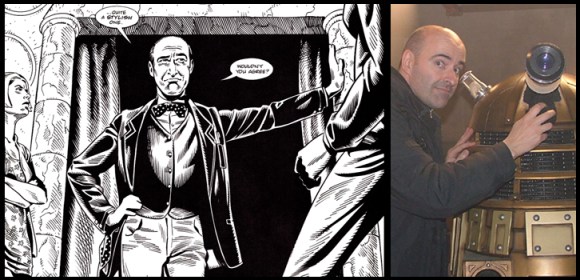
Following the TV-movie, the Eighth Doctor starred in the regular comic strip stories of Doctor Who Magazine. In 1998, the magazine decided to test if the readers were averse to having the Doctor regenerate again in the comic continuity. That way they could do their own version of the hero. In the story “Wormwood,” the Eighth Doctor fakes his own regeneration and has a friend masquerade as a new Ninth Doctor. This is part of a plan to distract some villains while the real Doctor does what he needs to do to save the day.
The false Ninth Doctor was based on Nicholas Briggs, who is famous of course for being the voice of the Daleks, Ice Warriors and Cybermen in the modern era, and who is one of the spearheads behind the Doctor Who audio dramas for Big Finish Productions. He also played a possible future incarnation of the Doctor in unlicensed dramas produced by Audio Visuals.
THE SHALKA DOCTOR
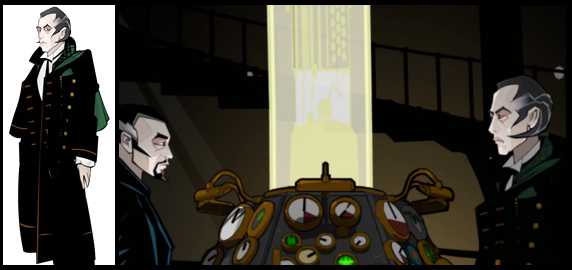
In 2003, fans were celebrating the 40th anniversary of Doctor Who and lamenting that the BBC still seemed unable or unwilling to bring the show back to TV. It was decided a new animated series streaming online would serve as the official continuation. The opening story, “Scream of the Shalka,” was written by Paul Cornell and featured Richard E. Grant, officially acknowledged by the BBC as the Ninth Doctor. Traveling with him was his old enemy the Master (played by Sir Derek Jacobi), who had been offered a chance for redemption, with his consciousness now residing in an android body made from parts of the TARDIS. “Scream of the Shalka” also included David Tennant, who asked if he could have a small role because he was such a fan of Doctor Who.
This was a very acerbic Doctor who felt inconvenienced at having to save Earth yet again and made sure everyone knew it. The idea was “Sherlock Holmes in space.” This version of the Doctor wore a black Edwardian tailcoat under a heavy cape, with a Keble College scarf thrown over his shoulder. It made him look a little vampiric.
Only “Scream of the Shalka” was released. When the BBC greenlit Russell T. Davies reviving Doctor Who for TV, the online animated show halted and was retroactively deemed out of continuity, a story from a parallel universe. Its hero gained the nicknames of “Shalka Doctor” and “REG Doctor” (for Richard E. Grant). Had the animated show continued, Cornell intended to reveal that after the TV-movie, the Doctor retired to Gallifrey and fell in love with a woman Time Lord. Then, Gallifrey was invaded and the Doctor’s plans for victory failed, resulting in the deaths of his love and the planet. Wishing to survive any way they could, the Time Lords uploaded their minds into the famous Matrix of Gallifrey. As part of the Matrix, the Time Lords could now control the TARDIS. So they now forced the Doctor to live the life of a hero again with the Master at his side. They would both save planets to make up for their past crimes and failures. This is what led the Doctor to be the reluctant, acerbic hero we met in “Scream of the Shalka.”
THE COMIC RELIEF DOCTORS
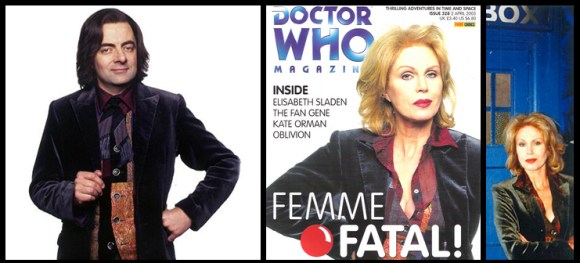
In March 1999, a Doctor Who comedy special was produced for the Red Nose Day charity telethon. “The Curse of Fatal Death,” written by Steven Moffat, took place years after the events of the TV-movie and featured comedy legend Rowan Atkinson as the Ninth Doctor. Joining him in the cast was Julia Sawalha as his fiancée Emma, and Jonathan Pryce as the Master. This Doctor was a throwback to an outfit William Hartnell or Patrick Troughton may have worn, a Dickensian wanderer wearing a vest over a red shirt, along with a string necktie.
The special involved the Doctor flipping through several other incarnations portrayed by Grant, Jim Broadbent, and Hugh Grant, all of whom wore the same apparel (no time for wardrobe changes). Finally, the Doctor used up his thirteenth life and met his end. But then, somehow, the universe itself decided the hero wasn’t done and a miracle happened. The Fourteenth Doctor emerged and was a woman who was excited about her new body, played by Joanna Lumley. This Doctor looked quite fetching in Atkinson’s outfit, which seemed to have regenerated as well, as the tie was gone and the shirt was open to show off her cleavage. Honestly, I think she looks good enough in this outfit that she should wear it often in her every day life.
THE UNBOUND DOCTORS
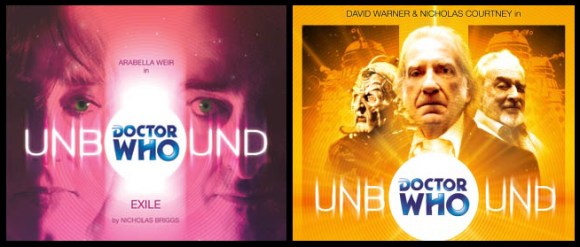
Big Finish Productions released several adventures under the banner Doctor Who Unbound, featuring events that were outside of continuity and actors who had never played the Doctor. Some of them tackled very specific “what if” scenarios. What if the Doctor had never left Gallifrey with his young granddaughter Susan? What if the Valeyard had won?
Though we couldn’t see them, fans enjoyed imagining these alternate Doctors. Arabella Weir (who later appeared in the 2011 Christmas Special) starred in the comedy story Exile as a female incarnation of the Doctor living incognito as supermarket employee “Susan Foreman.” David Warner appeared as a white-haired Doctor with mutton chops, who wore a black suit and white tie in the audio dramas Sympathy for the Devil (2003) and its sequel story Masters of War (2008). Other Doctors were played by Geoffrey Bayldon, Derek Jacobi, and David Collings.
Sympathy for the Devil‘s cast brought back classic series star Nicholas Courtney (who played the Doctor’s good friend Brigadier Alistair Gordon Lethbridge-Stewart), and included future Doctor actor David Tennant and actor/writer Mark Gatiss. If you don’t know Gatiss, he co-created the BBC’s Sherlock, recently wrote and produced the docudrama An Adventure in Space and Time, wrote several Doctor Who novels and episodes, and appeared on the modern day TV show as the Tenth Doctor’s enemy Prof. Richard Lazarus.
I think I’ve written enough now. Hope you enjoyed this talk about the alternate Doctors. If you have ideas for other topics and characters to tackle in the future, please feel free to leave us some comments. Until next time, this is Alan Kistler, Agent of S.T.Y.L.E., signing off!
Alan Sizzler Kistler (@SizzlerKistler) is an actor and the author of Doctor Who: A History.



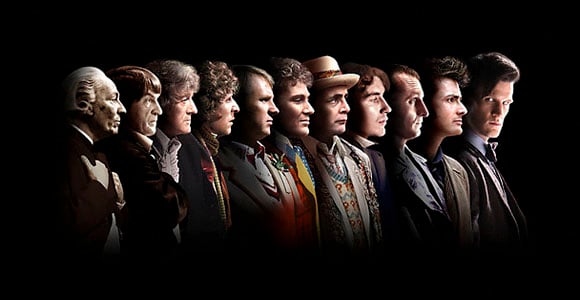





Published: Dec 27, 2013 02:00 pm